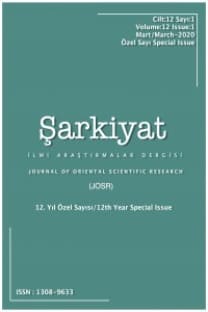YouTube Temelli Arapça Öğrenimine Akademik Bir Bakış
Günümüzde, eğitimde internet kullanımı hızla artmaktadır. Eğitimde internetin kullanıma girmesiyle, internet kullanımını verimli bir şekilde eğitime adapte etmekle ilgili pek çok yaklaşım ortaya çıkmıştır. Bu çalışma YouTube’un Arapça öğreniminde kullanımının detaylarına odaklanmıştır. Çalışma, “YouTube neden Arapça öğreniminde kullanılmalı? YouTube ile hangi Arapça becerilerimizi geliştirebiliriz? YouTube’u sınıflarımıza nasıl entegre edebiliriz? YouTube’un avantajları ve dezavantajları nelerdir?” sorularına yanıt aramaktadır. Çalışma neticesinde; YouTube’un Arapça eğitmenleri tarafından eğitim materyali olarak kullanılmasının faydalı olacağı kanısına ulaşılmıştır.
An Academic Look at YouTube-Based Arabic Learning
Today, the use of the Internet in education is increasing rapidly. With the introduction of the Internet in education, many approaches have emerged to adapt the use of the internet to education efficiently. This paper focuses on the details of the use of YouTube in learning Arabic. It is attempting to answer these questions; why should YouTube be used for learning Arabic? What Arabic skills can we improve on YouTube? How can we integrate YouTube into our classrooms? What are the advantages and disadvantages of YouTube? As a result of the study; It has been concluded that the use of YouTube as educational material by Arabic instructors would be beneficial.
___
- Albantani, Azkia Muharom - Madkur, Ahmad. “Musyahadat Al Fidyu: YouTube-Based Teaching and Learning of Arabic as Foreign Language (AFL)”. Dınamıka Ilmu 17(2) (2017), 291-308. https://doi.org/10.21093/di.v17i2.854
- Alhamami, Munassir. “Observation of YouTube Language Learning Videos (YOUTUBE LLVS)”. Teaching English with Technology 13(3) (2013), 3-17.
- Al-Huri, Ibrahim. “Arabic Language: Historic and Sociolinguistic Characteristics”. English Literature and Language Review 1(4) (2015), 28-36. https://doi.org/10.13140/RG.2.2.16163.66089/1
- Al-Sobh, Mahmoud A. - Abu-Melhim, Abdel-Rahman Husni. - Bani-Hani, Nedal A. “Diglossia as a Result of Language Variation in Arabic: Possible Solutions in Light of Language Planning”. Journal of Language Teaching and Research 6(2) (2015), 274-279. https://doi.org/10.17507/jltr.0602.05
- Burke, Sloane C. - Snyder, Shonna - Rager, Robin C. “An Assessment of Faculty Usage of YouTube as a Teaching Resource”. The Internet Journal of Allied Health Sciences and Practice 7(1) (2009), 1-8. https://doi.org/10.46743/1540-580X/2009.1227
- Treichler, DeForest G. “Are you missing the boat in training aids?”. Film and Audio-Visual Communication 1(1) (Şubat 1967), 14-16.
- El-Omari, Samir. “The Effect of Computer-assisted Language Learning on Improving Arabic as a Foreign Language (AFL) in Higher Education in the United States”. Procedia - Social and Behavioral Sciences 192 (2015), 621-628. https://doi.org/10.1016/j.sbspro.2015.06.109
- Ethnologue. “What are the top 200 most spoken languages?”. Erişim 4 Temmuz 2022. https://www.ethnologue.com/guides/ethnologue200
- Faryadi, Qais. “Techniques of Teaching Arabic as a Foreign Language through Constructivist Paradigm: Malaysian Perspective”. Eric: Institution of Education Sciences (2007), 1-20.
- Jalaluddin, Mohammad. “Using YouTube to Enhance Speaking Skills in ESL Classroom”. English for Specific Purposes World 17(50) (2016), 1-4.
- June, Sethela - Yaacob, Aizan - Kheng, Yeoh Khar. “Assessing the Use of YouTube Videos and Interactive Activities as a Critical Thinking Stimulator for Tertiary Students: An Action Research”. International Education Studies 7(8) (2014), 56-67. https://doi.org/10.5539/ies.v7n8p56
- Kwan, Reggie (ed.) - Fox, Robert (ed.) - Chan, F T (ed.) - Tsang, Philip. (ed.). Enhancing Learning Through Technology: Research on Emerging Technologies and Pedagogies. Singapore: World Scientific Publishing, 2008.
- Khaloufi, Az-Eddine - Laabidi, Hicham. “An Examination of the Impact of Computer Skills on the Effective Use of ICT in the Classroom”. Indonesian Journal of EFL and Linguistics 2(1) (2017), 53-69. https://doi.org/10.21462/ijefll.v2i1.29
- Mat, Hamidah. - Abas, Wan Mohammad Ubaidillah Wan. “The Relevance of Arabic Language in Islamic Studies Peogram: A Case Study of Open University Malaysıa (OUM)”. Journal of Education and Social Sciences 5(2) (2016), 205-209.
- Saeheng, Pornpimon. A Study of e-Learning, Blended learning, and Traditional Teaching Methods to Motivate Autonomous Learning in English Reading Comprehension of Thais Learners. Saen Suk: Burapha University, Faculty of Education, Doktora Tezi, 2017. http://digital_collect.lib.buu.ac.th/dcms/files/57820037.pdf
- Statista. “Most popular social networks worldwide as of January 2022, ranked by number of monthly active users”. Erişim 13 Temmuz 2022. https://www.statista.com/statistics/272014/global-social-networks-ranked-by-number-of-users/
- Sulaiman, Kamal-deen Olawale. “The Effects of Information and Communication Technologies (ICT) On the Teachings/ Learning of Arabic and Islamic Studies”. Ar-Raniry: International Journal of Islamic Studies 2(1) (2014), 1-26. https://doi.org/10.20859/jar.v2i1.27
- TC, TechCrunch. “Facebook now has 2 billion monthly users… and responsibility”. Erişim 12 Temmuz 2022. https://techcrunch.com/2017/06/27/facebook-2-billion-users/
- Wekke, Ismail Suardi. “Arabic Teaching and Learning: A Model from Indonesian Muslim Minority”. Procedia - Social and Behavioral Sciences 191 (2015), 286-290.
- YOB, Youtube Official Blog, “Youtube for Press”. Erişim 8 Temmuz 2022. https://blog.youtube/press/
- Başlangıç: 2009
- Yayıncı: Şarkiyat Araştırmaları Derneği
Sayıdaki Diğer Makaleler
Okul Ethosu ve Etik Karar Verme
Diyarbakır Milletvekili Zülfü Bey'in Malta'ya Sürgünü
Hz. Peygamber’e (s.a.v.) İsnad Edilen Olumsuz Söz ve Fillerle İlgili Bir Hadisin Tahrîc ve Yorumu
Tunus'taki Tasavvuf Akımı ve 15.Yüzyıldan 16.Yüzyıla Kadar İktidarla İlişkisi
Yapay Zekaya Dair Etik Sorunlar
YouTube Temelli Arapça Öğrenimine Akademik Bir Bakış
İslam Borçlar Hukukunda Satış Konusunun Maddi Olarak Var Olması Şartına Dair Bir Değerlendirme
XVI. Yüzyıl Kudüs Sancağı’nda Bir Köy: Beytülahm
